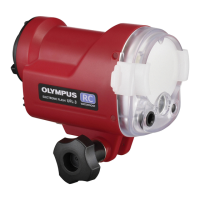
Do you have a question about the Olympus UFL-3 and is the answer not in the manual?
| Power Source | 4 x AA batteries |
|---|---|
| Weight | 500 g (without batteries) |
| Dimensions | 90 x 90 x 200 mm |
| TTL | Yes |
| Type | External |
| Guide Number | 28 (ISO 100, meters) |
Important warnings and information to read before operating the precision device.
Explains symbols like Danger, Warning, and Caution for safe operation.
Covers high voltage, fire, explosion risks, and pointing flash at drivers.
Warnings about flash in eyes, keeping away from children, and swallowing parts.
Procedures for water contact, internal damage, and electrical shock risks.
Avoiding high/low temperatures, vibrations, sand/dust, and improper handling.
Rules for preventing leaks, overheating, short circuits, and ensuring dry conditions.
Identifies batteries with insufficient insulation that must not be used.
Proper handling of NiMH charging, cracked batteries, leaks, heat, and long-term storage.
Importance of O-ring, cleaning foreign matter, greasing, and proper installation.
Avoiding specific locations and chemicals for cleaning/repair of the flash.
Identifies main external parts and accessories of the flash unit.
Lists items included in the electronic flash package.
Labels specific numbered parts of the flash unit and its accessories.
Step-by-step guide on how to safely remove the O-ring from the battery cap.
Instructions for cleaning foreign matter from the O-ring and its groove.
Step-by-step guide on applying silicone grease to the O-ring for maintenance.
Procedure for correctly fitting the O-ring back into its groove and sealing the cap.
Specifies the types of batteries compatible with the flash unit.
Step-by-step guide for inserting batteries into the flash, noting polarity.
Instructions on how to properly close and lock the battery cap after insertion.
Guide on how to securely attach the flash to a mounting arm.
Instructions for connecting the flash to a camera's underwater housing via fiber optic cable.
How to power on the flash and check its readiness for TTL operation.
Details on using RC A and RC B modes for TTL flash photography.
Steps to take photos using TTL auto-modulation with the flash.
How to configure the flash for manual slave mode operation.
Instructions for correctly attaching the included diffuser to the flash unit.
How to safely remove the diffuser from the flash unit.
Procedures for rinsing and cleaning the flash after use, especially saltwater exposure.
Proper methods for drying the flash unit after cleaning to prevent damage.
Performing O-ring maintenance after each use to ensure waterproofing.
Recommendations for replacing the O-ring annually or if it shows signs of wear.
Cautions for safely opening and closing the battery cap to prevent water/sand entry.
Guidelines for avoiding damage and ensuring proper usage and storage of the flash.
Lists common reasons for water leakage into the flash unit.
Key points and recommendations for effective O-ring maintenance.
Important points for flash unit maintenance and chemical restrictions.
Guidance on repairs, warranty, and model numbers for available accessories.
Recommended white balance settings for the camera when using the electronic flash.
Troubleshooting steps for when the flash doesn't emit in RC mode.
How to determine if a camera is compatible with wireless flash features.
Detailed technical data including model, type, guide number, dimensions, and waterproofing.